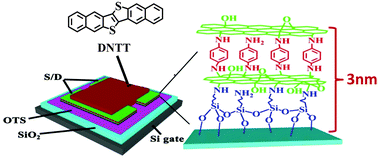Minimizing electrode edge in organic transistors with ultrathin reduced graphene oxide for improving charge injection efficiency†
Abstract
Electrode materials and geometry play a crucial role in the charge injection efficiency in organic transistors. Reduced graphene oxide (RGO) electrodes show good compatibility with an organic semiconductor from the standpoint of energy levels and ordered growth of the organic semiconductor, both of which are favourable for charge injection. However, the wide electrode edge (>10 nm) in commonly-used RGO electrodes is generally detrimental to charge injection. In this study, ultrathin (about 3 nm) RGO electrodes are fabricated via a covalency-based assembly strategy, which has advantages such as robustness against solvents, high conductivity, transparency, and easy scaling-up. More remarkably, the ultrathin electrode fabricated in this study has a narrow edge, which may facilitate the diffusion and assembly of organic semiconductors and thus form a uniform semiconductor film across the electrode/channel junction area. As a result, the minimized electrode edge may significantly improve the charge injection in organic transistors compared with thick electrodes.



 Please wait while we load your content...
Please wait while we load your content...